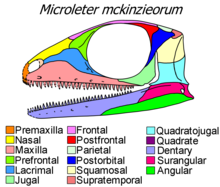Microleter
| Microleter | |
|---|---|

| |
| Skull diagram | |
| Scientific classification | |
| Domain: | Eukaryota |
| Kingdom: | Animalia |
| Phylum: | Chordata |
| Class: | Reptilia |
| Clade: | †Parareptilia |
| Order: | †Procolophonomorpha |
| Node: | †Ankyramorpha |
| Genus: | †Microleter Tsuji et al., 2010 |
| Type species | |
| †Microleter mckinzieorum Tsuji et al., 2010
| |
Microleter is an
Discovery
The only known specimen of Microleter is a well-preserved skull and lower jaw designated as OMNH 71306, the holotype specimen. It was found at the Dolese Brothers limestone quarry near Richards Spur in Comanche County, Oklahoma.[1] Historically referred to as the Fort Sill locality, the quarry has preserved Early Permian (Artinskian, ~289-286 Ma) fissure fills in an Ordovician cave system. The fissure fills have yielded many other well preserved tetrapod fossils, including the most diverse assortment of Permian parareptiles in North America.[2]
Microleter mckinzieorum was named by paleontologists Linda A. Tsuji, Johannes Muller, and Robert R. Reisz in 2010. The genus name combined Greek "mikros" (small) with "-oleter" (murderer), a suffix common to parareptile genera. The specific name honors the McKinzie family, as the specimen was discovered by Mark McKinzie.[1]
Description

Based on the skull's large
The front edge of the orbit was thick due to an internal flange on the
Most of the
Classification
Microleter is one of the most
The original description of Microleter used
Cladogram from the bayesian analysis of Tsuji, Muller, & Reisz (2010):[1]
However, since the original description, various other analyses have each had slightly different conclusions on the position of Microleter, placing it as the sister taxon of Australothyris,[6] basal to Australothyris,[7] or as a basal ankyramorph more derived than lanthanosuchoids,[8][5][9][10][11]



